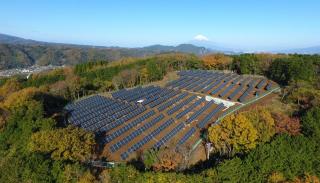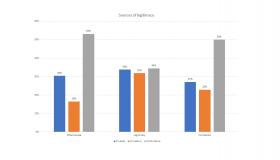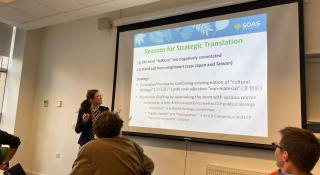
Breadcrumbs navigation
How do stakeholders perceive institutions in a field with institutional complexity? Understanding legitimacy in global renewable energy governance
Naghmeh Nasiritousi and Hugo Faber discuss their new article published in BISA journal Review of International Studies. The article contributes to the literature on legitimacy by providing new insights into the sources of legitimacy among international institutions that operate under institutional complexity.
Scholarship on legitimacy has advanced fast in the last few years. Recent studies have highlighted the importance of institutions being considered legitimate in order to be stable and function effectively. While much conceptual work has been carried out to understand sources of legitimacy, few empirical studies examine how stakeholders in fact perceive the legitimacy of institutions. Moreover, as global governance institutions have proliferated in different fields, there is competition between institutions over members and resources. What this means for issues of legitimacy of global governance institutions is explored in our recent article ‘Legitimacy under Institutional Complexity: Mapping Stakeholder Perceptions of Legitimate Institutions and their Sources of Legitimacy in Global Renewable Energy Governance’.
Studying legitimacy
Legitimacy is a central concept for governance scholars, since legitimacy can generate compliance with shared rules without the need for inducement or coercion. Simply put, legitimate institutions are those that have obtained acceptability and credibility in the eyes of the community that it seeks to govern. Based on previous literature, we argue that there are primarily three sources of legitimacy for institutions: purpose, procedure and performance. These three broad categories of sources of legitimacy encompass the institution’s aim and its internal properties to fulfill this aim (purpose), the internal processes of the institution (procedure), and what it produces (performance).
Interestingly, the scholarly debate on the sources of institutional legitimacy has focused mostly on the procedure and performance of institutions. Purpose has typically been discussed in the literature as the social purpose of an institution, including a legitimate goal and rationale. We take a broader view of purpose and also include an institution’s mandate and its basic set-up so that purpose includes not only goals and rationale, but also the identity and internal properties of an institution. A reason why purpose has not been examined to a great extent may be that procedure and performance matter more when comparing the legitimacy of institutions across different fields. Within a single institutional regime complex, however, many institutions have overlapping functions and therefore we posit that purpose may matter more to perceptions of legitimacy. In other words, when there are more than one institution working in the same field, perceptions of legitimacy may be shaped by the existence of alternative governance arrangements with slightly different purposes.
Why global renewable energy governance?
The global renewable energy field can be seen as a case of a wider trend in global governance whereby authority in a given issue-area is increasingly shared between a set of institutions with varying memberships. With a proliferation of institutions within a given governance field, the operations of individual institutions become more inter-dependent, which may have implications for their legitimacy. While our paper does not focus on how institutional complexity affects legitimacy, it does seek to understand the legitimacy perceptions of stakeholders in an institutionally complex governance field. The global renewable energy field is interesting to study both from an academic and a policy perspective. The field is characterized by multiple institutions working at different levels involving a range of different sectors, actors, and interests. Moreover, it is widely agreed that addressing climate change requires the transformation of energy systems. Since the Sustainable Development Goal (SDG) #7 is to ‘Ensure access to affordable, reliable, sustainable and modern energy for all’, the need for international cooperation has increased to remove barriers for joint projects and encourage international policy coordination. The effectiveness and legitimacy of institutions in this field are thus of great importance for achieving this goal.
Global renewable energy governance has seen a significant rise in the numbers of institutions in the last few decades. Except for the International Solar Energy Society that was established already in 1954, the oldest institutions in global renewable energy governance date back to the 1970s and were initiated as a way of managing rising energy security concerns after the OPEC oil crises. The number of institutions in global renewable energy governance began to grow in the 1990s, primarily due to the growing salience of the climate change issue, manifested in the adoption of the United Nations Framework Convention on Climate Change (UNFCCC). Today renewable energy governance is populated by a large number of institutions with varying forms and functions, and without a clear division of labor.
This proliferation of institutions means that institutions dealing with renewable energy have notable differences when it comes to mandate and aim (purpose), inclusion and decision-making practices (procedure), and types of outputs (performance). Given this context, our study examines two pertinent questions: Which institutions working within the same issue-area are considered most legitimate and why?, and how do these perceptions of legitimacy vary across different stakeholder groups?
Stakeholder perceptions mapped
Our paper employs unique questionnaire data that gauges the views of climate and energy experts. In contrast to much of the previous literature that captures the concept of legitimacy by asking about confidence or support for specific institutions, our survey examines legitimacy through a set of open questions, providing the respondents the chance to themselves identify what makes an institution legitimate. Three open questions were posed to capture different dimensions of legitimacy. First, respondents were asked which institution for promoting renewable energy globally that they considered to be the most effective and to specify why, thereafter which institution that they considered to be the most legitimate and to specify why, and thirdly which institution that they had the most confidence in, and why. By asking three questions, two of which are biased towards procedure and performance respectively, we can compare the results from all three questions to each other and get a better understanding of how the way legitimacy is measured affects the results. Our respondents include a wide variety of stakeholders, including representatives from national, regional, and local governments, businesses, NGOs, academia, and intergovernmental organizations.
Results, conclusions and future research
The survey results provide four central findings. First, on the whole, the picture that emerges is one where many types of institutions are considered relevant in global renewable energy governance. Nevertheless, the International Renewable Energy Agency (IRENA) had the broadest backing amongst climate and energy experts no matter how we asked, followed by the International Energy Agency (IEA) and UNFCCC.
Second, while performance was the most mentioned source of legitimacy, the purpose of an organization turned out to be a strong source of legitimacy for global renewable energy governance institutions, closely followed by procedure. When there exist institutions with similar functions yet different set-ups, the purpose and identity of the institutions are likely to matter as stakeholders evaluate the legitimacy of a set of alternative institutions. Thus, at least under institutional complexity, scholarly work on legitimacy should go beyond the procedure – performance discussion and include the purpose-related dimension as well.
Third, our results suggest that legitimacy perceptions in global renewable energy governance vary in systematic ways between different stakeholder groups. Our results indicate that a wide set of climate and energy experts have confidence in IRENA but that confidence in the IEA and the UNFCCC for promoting renewable energy vary more depending on the background of respondents. Finally, our results suggest that legitimacy appears to be primarily associated with state-led institutions, even though multi-stakeholder institutions and private-public partnerships have proliferated in recent years and do relatively well on the confidence indicator.
Our sub-categorizations of answers provide a more fine-grained analysis of what the sources of legitimacy are for these institutions. The performance category is dominated by answers that pertain to the institution’s output, and to a lesser extent outcome. Examples of answers include good data, quality research, project financing, and technology development and dissemination. The purpose category is dominated by an institution’s aim, focus of work, mandate, and capabilities in terms of staff and resources. Examples here include having a mandate to promote all renewable technologies, having an international scope, being focused on renewable energy, and having access to resources, such as financial and political capital. The procedure category is dominated by answers related to inclusion, collaboration, and non-bias. Examples include the institution’s inclusion of relevant actors (with an emphasis on universal institutions) and openness to collaborations, as well as being independent institutions without conflicts of interest.
These results generate hypotheses about sources of legitimacy, differences in perceptions of legitimacy between stakeholder groups, and new versus old institutions that can be explored in further research. Two factors that appear to affect legitimacy perceptions towards an institution positively, are including many states as members and holding expertise in the issue area. The most frequently mentioned institution, IRENA, has both of these qualities. The IEA has fewer members and is less specialized on renewable energy. Nevertheless, a considerable part of the legitimacy of the IEA seems to be due to its widely acknowledged expertise. The UNFCCC has the most members out of these institutions but cannot compete with IRENA or IEA when it comes to expertise in renewable energy issues. Our results indicate that these institutions, operating in a fragmented governance landscape, fill various roles and have different comparative advantages. While IRENA is considered the most legitimate institution in the renewable energy field, it is possible that the IEA would be considered more legitimate in the broader energy field and the UNFCCC in the climate change field. Because of increasing institutional complexity, institutions’ legitimacy is thus likely to be dependent on keeping themselves relevant for, and conforming to the normative expectations of, a number of stakeholder groups. Taken together, this highlights the importance of outreach activities by institutions, in order not only to inform stakeholders about their ongoing work, but also to solicit input from key stakeholders.
Further research would be required to understand whether our findings are generalisable into other issue-areas. Future studies could also further examine the relationship between legitimacy of individual institutions and the overall governance field, how patterns of cooperation and competition affect legitimacy, as well as why stakeholders hold the perceptions that they do.
Figure 1

Institutions mentioned in answers to questions about effectiveness, legitimacy and confidence as a percentage of total answers
Figure 2

Reasons for highlighting an institution as most effective, most legitimate, or most confidence in
You can read the full article at DOI: https://doi.org/10.1017/S0260210520000431
BISA members receive access to RIS (and to our other journal European Journal of International Security) as a benefit of membership. To gain access, log in to your BISA account and scroll down to the 'Membership benefits' section. If you're not yet a member join today.
Photo by Mark Merner on Unsplash


